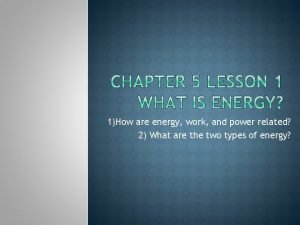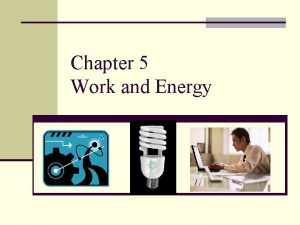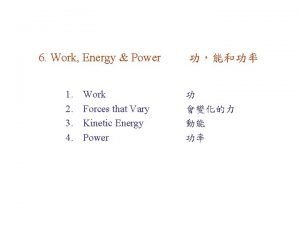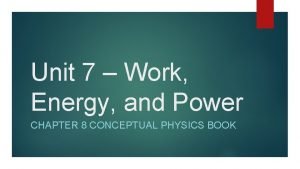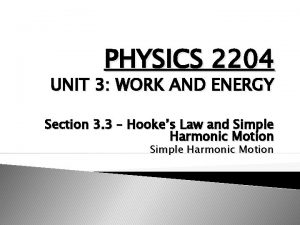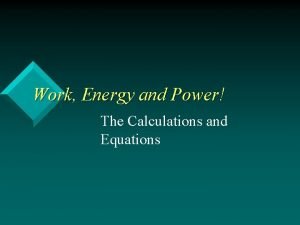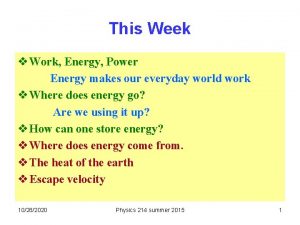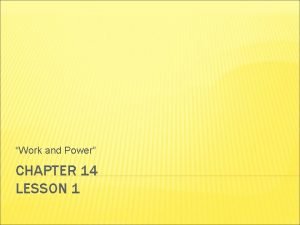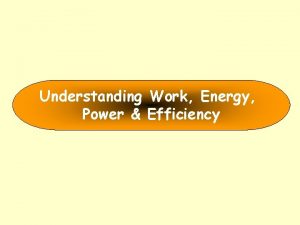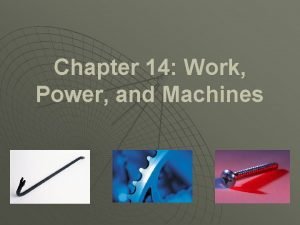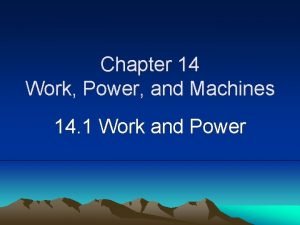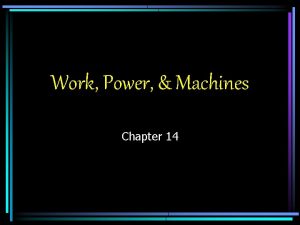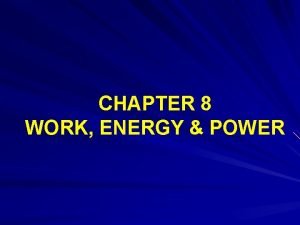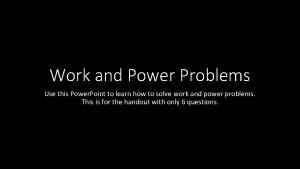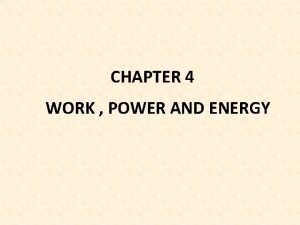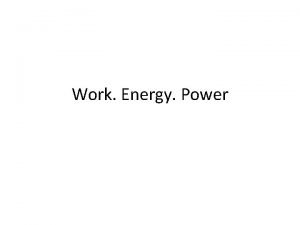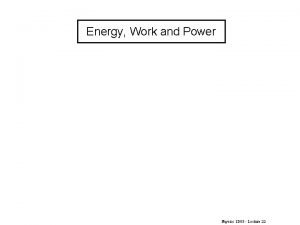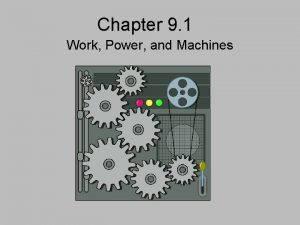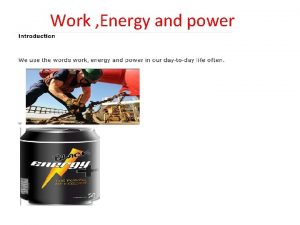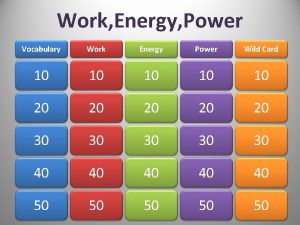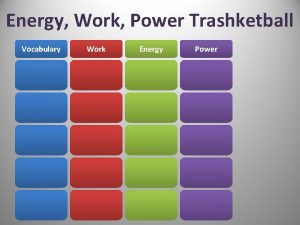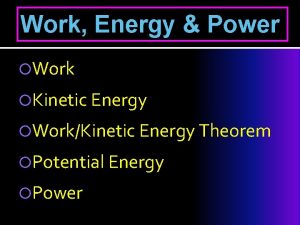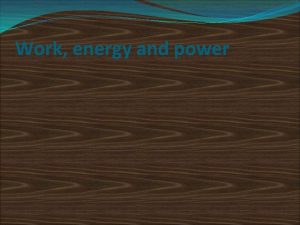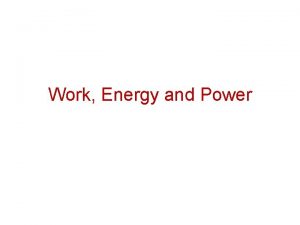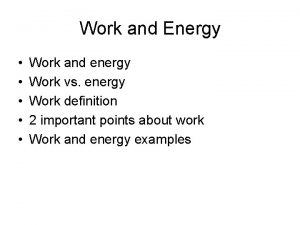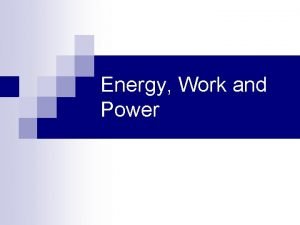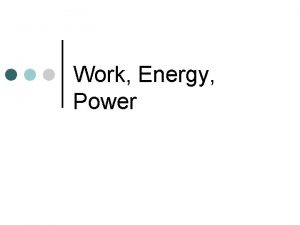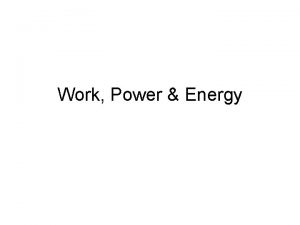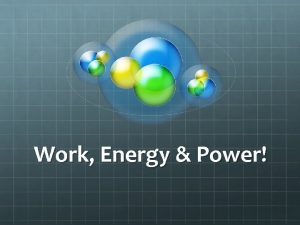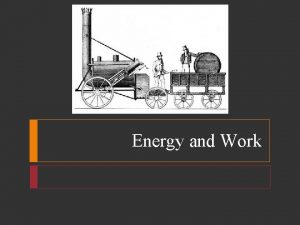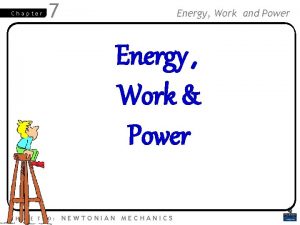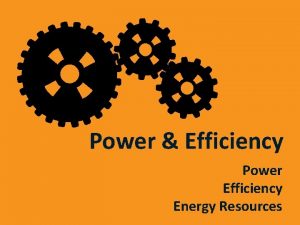Work Energy and Power What is energy Energy




































- Slides: 36

Work, Energy, and Power

What is energy? • Energy – the ability to do work. • Every source of energy you can think of fits the above definition. List three: • 1) __sunlight___ • 2) __heat____ • 3) __food_____

Work • • What is work? Work – Definition has 2 parts in physics. 1) A force must have been exerted. 2) The object being worked on must have moved or changed.

• If I push the wall as hard as I can, is work being done to the wall? • No. • Thought process: • Did the wall move? Did the wall change? • If the answer to both of those is “no”, then no work was done.

• If I push a desk around, was work done to the desk? Yes • If you sit in your desk to take a quiz, is work being done to the desk? No • If you squeeze a ball of play-doh, was work done to the play-doh? Yes • If you fold a piece of paper on the desk, was work done to the paper? Yes To the desk? No

• • • There are 2 formulas for calculating work. The first formula: W = F x d W = work F = Force D = displacement. Remember, the “W” is big, because little “w” means “weight. ”

• Force x displacement in units would be Newtons x Meters • The Joule (J) is N x m. • Joule is our unit for work.

• THE CATCH!!!!! • The force and displacement in the formula have to be in the same direction.

• Is work done to the box when it’s pushed along the table? Yes • Is work done to the box when it’s picked up? Yes • Is work done to the box if I hold it? No • Is work done to the box if I hold it and walk to the left? No

• The SECOND formula for Work is: • W = m x g x h. • W = work, m = mass, g = gravity, h = height. • Part of this formula is m x g. What was m x g the formula for? weight • So this formula can also be written as: • W = w x h.

• W = F x d is for “mechanical work. ” • Mechanical work is the work done by machines. • W = m x g x h is for “work against gravity. ” • This is work done whenever the object is moved upwards, or against gravity.

Power • We compare strengths of work by comparing it’s Power. • We abbreviate this with a capital “P. ”

• Your formula for calculating Power is • P=W • T • Powers often compare different objects. • Example: Power for cars is measured in horsepower.

Inclined Plane • An inclined plane is a ramp that connects a upper level (usually the ground) to an lower level. • In fancy physics words, inclined planes turn work against gravity into mechanical work.

• The W = F x d (mechanical work) is the work done by pulling/pushing something up the ramp. • The W = m x g x h (or W = w x h, work against gravity) would be done by lifting something without the ramp.

• The mechanical work will ALWAYS equal the work against gravity in the calculations.

For the Lab • What were you doing work against when you were walking up and down the stairs?

Energy • Energy is the ability to do work. • That means energy causes forces that cause movement or change.

Work-Energy Theorem • BUT when work is done to matter it creates energy! • So energy creates work, and work creates energy. • This is called the work-energy Theorem.

• Because of theorem, both work and energy are measured in Joules. • An machine that creates mechanical work from energy is a motor. • An machine that creates energy from mechanical work is a generator.

Different Types of Energy! • Kinetic energy is energy from things in motion. • Potential energy is energy that’s being stored from objects at rest. • There are different types of these energies, too! Lets draw them!

Translational Kinetic Energy (KE) • Energy from motion.

Rotational KE • Energy from spinning.

Vibrational KE • Energy from vibrating.

Mechanical KE • Energy from gears moving or mechanical pieces working together.

Gravitational Potential Energy (GPE) • The energy something has before it falls.

Elastic PE • The energy something has when stretched out to go back to the way it was.

Chemical PE • The energy chemicals have to react.

Other forms of energy! Electricity • Electricity, like what’s from your plugs or lightning.

Thermal • Heat

Radiant • Light (like sunlight)

Nuclear • Energy from a nuclear chemical reaction, caused by fusion or fission.

To Calculate GPE • • • GPE = m x g x h. GPE = Gravitational Potential Energy m = mass g = gravity h = height This is the same formula as the work against gravity formula!

Calculating Translational Kinetic Energy • TKE = ½ m x v 2 • m = mass • v = velocity

Law of Conservation of Energy • Energy can neither be created nor destroyed. • Energy can go back and forth between potential and kinetic, but the total amount of energy will always be the same. • So when asked to find the total energy add all the numbers.

• 99. 9% of energy for earth comes from sunlight. That causes all the wind, weather, ocean currents, photosynthesis, and the processes by which we get fossil fuels. Only. 1% of earth’s energy comes from geothermal heat/volcanos, or earth’s rotation.
 Chapter 4 work and energy section 1 work and machines
Chapter 4 work and energy section 1 work and machines Real power and reactive power
Real power and reactive power Work, power and energy activities
Work, power and energy activities Work done definition
Work done definition How are work and power related
How are work and power related Work power energy and machines
Work power energy and machines F d cos theta
F d cos theta Work power
Work power Jenis usaha apa
Jenis usaha apa Physics 03-01 work and the work-energy theorem
Physics 03-01 work and the work-energy theorem Regents physics work power energy
Regents physics work power energy Work and energy
Work and energy Physics 2204 unit 3: work, power, energy
Physics 2204 unit 3: work, power, energy Work energy power equations
Work energy power equations Work and energy physics
Work and energy physics Work and energy section 2 describing energy answer key
Work and energy section 2 describing energy answer key Solar power satellites and microwave power transmission
Solar power satellites and microwave power transmission Actual power
Actual power Mobile ka
Mobile ka Work power and efficiency
Work power and efficiency Define work and power
Define work and power Unit 14 lesson 1 drivers ed
Unit 14 lesson 1 drivers ed Physics define work
Physics define work How to calculate work and power
How to calculate work and power Chapter 14 work power and machines
Chapter 14 work power and machines Work power and machines
Work power and machines Chapter 14 work power and machines
Chapter 14 work power and machines Chapter 8 work and power answers
Chapter 8 work and power answers Work and power problems
Work and power problems Work and power definition
Work and power definition Energy versus work
Energy versus work Kids and the power of work
Kids and the power of work Kids and the power of work
Kids and the power of work Power formula physics
Power formula physics A crate of bananas weighing 3000 n
A crate of bananas weighing 3000 n Smart vs hard working
Smart vs hard working Energy energy transfer and general energy analysis
Energy energy transfer and general energy analysis




